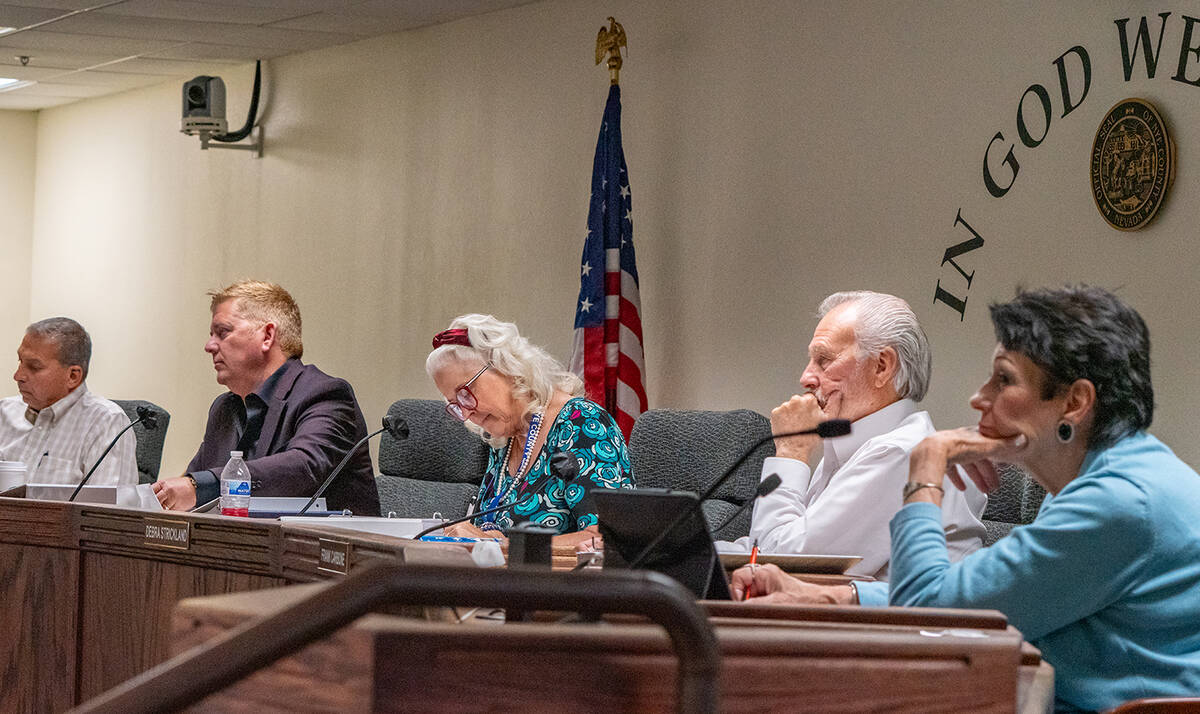Nye County’s solar regulations set – here’s when they go into effect
Starting Monday, Jan. 6, Nye County’s moratorium on commercial solar development applications will expire and the new regulations for that industry, which have taken more than two and a half years to draft, will officially go into effect.
Nye County Ordinance No. 611 fully repealed Nye County Code Chapter 17.10 in its previous version and replaced the section with all-new language that is intended to address the concerns surrounding the burgeoning solar industry. As detailed in the Nye County Commission’s Dec. 17, 2024 agenda, “The purpose of this ordinance is to regulate the location, construction and operation of commercial renewable energy generation facilities, above-ground transmission lines (not located within an established utility corridor), battery storage systems, electrical substations and gen-tie connections.”
The public hearing on the bill creating the ordinance had been continued from the board’s Dec. 3, 2024 meeting due to suggested amendments to the proposed code, which Nye County Planning Director Brett Waggoner delineated on Dec. 17. The major amendment to the proposed language focused on the setback requirements, which was originally pegged at a quarter-mile from residentially zoned property.
“The board’s suggestion was one mile,” Waggoner stated. “In discussions with the industry and trying to negotiate some parameters for the setbacks, a lot of projects, the mile isn’t really an issue… What the industry – the consortium that I have been working with on this - is requesting is that it read, ‘If an applicant proposes a project within the PRPD, no solar panel shall be located less than one-quarter mile from a residentially-zoned property line or three-quarters of a mile from a residential structure.”
Nye County Commission Chair Debra Strickland was obviously frustrated by this.
“We made recommendations when we met last that it say one mile, and you’re saying that the industry would like to see that a quarter-mile? I cannot…” she remarked, letting her statement trail off as she appeared to grasp for the words to express her feelings.
Commissioner Bruce Jabbour was able to pick out some choice words, however, stating, “That’s nice and I certainly respect and appreciate the industry’s wants and needs for a setback… Anything less than a mile will absolutely effect and impact their property values, their home values, etcetera… We do not want to hurt our residents in any way…”
With it clear that the commission was not about to waver from its one-mile setback suggestion, Waggoner moved on to other amendments to the proposed ordinance. Another setback suggestion was to prohibit solar panels within a half-mile of Highway 160 and ensure that solar panels do not exceed 25-feet in height at their extended rotation.
The ordinance does include a variance provision. However, a variance application comes with a host of requirements, such as a stipulation that the applicant must obtain an executed agreement with relevant stakeholders and provide either a showing of good and sufficient cause, showing of financial hardship if the variance is not granted or evidence that the variance would not result in a nuisance.
In addition, variance applicants will be required to hold three public meetings to inform the community of the purpose and need behind its application, notice of which is required to be mailed to all property owners located within a quarter-mile of the subject property as well as posted in the local newspaper no less than 10 days prior to said meetings.
Other changes included the removal of all references to wind-related projects, which are to be addressed at a later date. The reference to a removal depth of five-feet in the decommissioning section was also removed, with Waggoner stating, “So basically, you pack it in, you pack it out.”
A requirement to contact and consult with the Nevada State Historic Preservation Office was also incorporated, as was a dictate to work with tribal councils near project sites and present to various community entities, such as the Nye County Water District Governing Board and local town boards.
Roughly an hour of public comment preceded the board’s vote on the matter and as expected, there were many vocal residents out to air their opinions. In contrast to previous meetings on the subject, however, much of the comment was from members of the International Brotherhood of Electrical Workers - a union with approximately 60 members who call Pahrump home - providing a counterweight to what has typically been a unified display of opposition by valley residents.
There were plenty of detractors to be heard, as well, some of whom wanted to see the county’s moratorium on renewable energy projects continued and others who were questioning why such developments couldn’t be banned from the Pahrump Valley entirely.
Turning to Nye County District Attorney Brian Kunzi, commissioner Frank Carbone strove to illustrate the reason a ban was not possible.
“What’s our authority?” Carbone asked.
“To think that you are going to be able to ban these things through some type of an ordinance is a very dangerous thought,” Kunzi replied. “The safeguards that are put in here, certainly nothing is perfect but there are a lot… of issues that pop up and you can deal with those things through the development agreement.”
He emphasized that the county’s laws are subservient to those of the state and federal government, noting, “Not having something, you’re at risk of having this jammed down your throat. Like everything else, once you have something in place like this, it’s harder for the state to try to push us aside.”
Commissioner Donna Cox clarified, “So we have this ordinance – is that going to mean that each individual project is going to have to come forward with a development agreement?”
“It absolutely requires them to come forward with a development agreement where you can then pick and go through that project very carefully to identify whatever risks are involved. That’s the whole part of the impact fees and things of that nature, to ameliorate whatever risks are being created by their project,” Kunzi stated.
The ordinance may not empower the county to outright ban solar projects but it does give the county the ability to legally defend against specific projects based on particular environmental or community concerns, he added.
Commissioner Ron Boskovich reiterated, “So the only control we have is this. That’s just kind of where it’s at.”
Strickland made the motion to adopt Nye County Ordinance No. 611 with the amendments as detailed by Waggoner and with a one-mile setback requirement. That motion passed with all in favor.
The new ordinance should be posted to the Nye County website once it goes into effect.
Contact reporter Robin Hebrock at rhebrock@pvtimes.com

















